Fujifilm seems to believe cameras stopped getting better in about 1954, and it might be right: its high-end X-series takes its cues from the Leica cameras of decades ago, and the results have been beautiful. The X10 is a slightly more consumer-friendly (read: less expensive) model than the previously released X100, costing $599 instead of the X100’s $1,199. The look is still the same, and although the specs aren’t as impressive as the X100 they’re still high-end: f/2.0 lens, 12-megapixel CMOS sensor, optical viewfinder, and all the manual control you could need. But even at the low, low price of $599, the X10 has to compete with Micro Four Thirds and Sony’s NEX cameras, which don’t look quite as cool but shoot images and video that are hard to beat. Does the X10 measure up with the best of its competitors, and is its beauty more than skin deep? Read on for our full review.
Video Review
Video Review
Hardware / design
Did I mention the X10 is gorgeous? It nails the retro style, and it’s much more reminiscent of the Leica M3 than just about any other camera out there today. (Except the X100, obviously.) The camera’s black magnesium body is accented with synthetic leather, and it has a blocky, simplified look that I really like. It’s not small, though, and at 4.6 inches wide and 2.2 deep there’s nothing pocket-friendly about it. It’s heavy, too, but it’s 12.3 ounces is a little easier to hold thanks to a small grip on the right side.
Fujifilm makes good use of all that space, adding more switches, buttons, and dials than you’d think could fit on a camera this size. Up top there’s the pop-up flash, shutter button, mode dial, exposure dial, and function button. There’s also a hotshoe, so you can add a flash, electronic viewfinder, or any of a variety of other accessories — flexibility that masks a multitude of sins on a camera this expensive, like the relatively unimpressive flash. I’d need five hundred words to explain everything on the back of the camera, so suffice to say there are plenty more buttons and dials, along with an optical viewfinder off to the left side. I particularly liked the dedicated button for switching to RAW shooting, and the assignable Fn button that became my one-touch ISO control. The front remains nicely minimal, with the viewfinder window, lens, focusing toggle, and little else.
The LCD on the back is a relatively small 2.8 inches, but it’s packed with 460,000 dots and is pretty sharp for this size. There are plenty of less-expensive cameras with 921,000-dot LCDs, though, so I have a hard time justifying a $600 camera not having a best-in-class display. It can also be a little slow to recognize color changes, especially in white balance — I’d occasionally take a shot, correctly balanced, before the LCD would look right. Otherwise, it’s bright, crisp and accurate enough to work well.
One neat feature, which I quickly grew to love, is the lens’ control over the power of the camera. If you rotate it one stop past the 28mm spot on the lens, it actually turns the camera off. To turn it on again, just spin the lens out like you’re zooming in, and on goes the camera. It takes a few seconds to turn on, so it’s not quite as seamless as it could be, but it’s an awesome trick. (If you don’t want to extend the lens while you review photos, you can just press the Play button for about three seconds, and the LCD turns on.)
Viewfinder
Its most obvious tribute to Leica, other than the device’s look, is Fujifilm’s use of a rangefinder-style optical viewfinder instead of the through-the-lens mirror style of most DSLRs. There are plenty of advantages to a rangefinder, but one giant, game-changing disadvantage: you never know exactly what you’re getting from your shot.
My hunch is that the optical viewfinder is going to cause a lot of average users, seduced by the X10’s beauty, a lot of confusion and annoyance as they shoot. Since the viewfinder has a different point of view than the lens, any photo you frame through the viewfinder will look different in the actual photo unless you know how to compensate for the difference. If I framed a picture of my keys through the viewfinder, what I actually took a photo of was the bottom of the lanyard, out of focus, plus a nice shot of the background. It also has no center mark or indication of focus — it’s just a blank pane of glass, with no information whatsoever — which makes framing your shot even more difficult because everything always appears to be in perfect focus whether it actually is or not. You’ll see the lens in the corner of the viewfinder as well, and while that’s neither unique to this camera nor a problem in your actual photos, it’s jarring to look at. On the plus side, the viewfinder does zoom in with the lens. If you can handle a rangefinder-style viewfinder, this one works as well as any, but I’d wager most people can’t. The X100 has a super-useful hybrid viewfinder that works much better, and I’d like the X10 more if it used the same system.
The X10 is stunning, but form occasionally trumps function
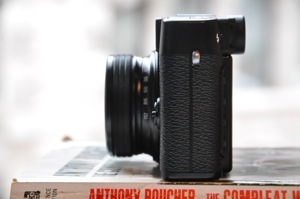
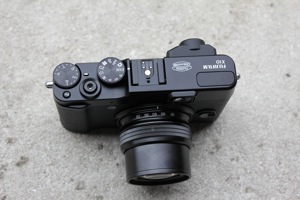
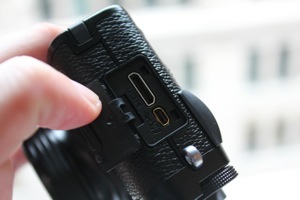
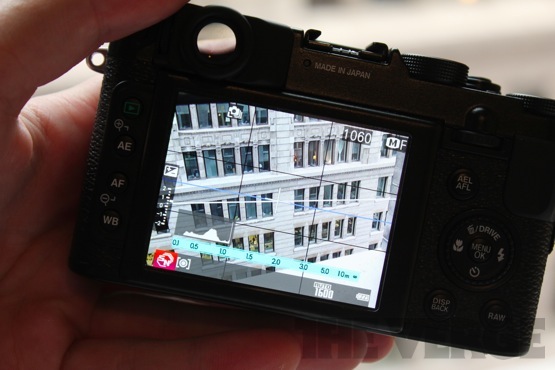
There’s a dial or button for everything you could possibly ever need to do on the X10, and probably two or three — I counted six things you can spin, one you can slide, and 14 you can press. Things are relatively well-marked, and most are fairly obvious, but there’s definitely a learning curve as you figure out where everything is, and which wheel you spin to do what. Once you get it, though, the camera’s as fast to navigate as any I’ve seen.
Same goes for the menu system, which is once again incredibly useful but also hard to figure out at first. Pressing the Menu button once brings up a list of common settings you might want to change, specific to the mode you’re shooting in. Pressing up on the five-way directional pad takes you to even more shooting options, and the AE and AF buttons control exposure and focusing options, respectively. Everything’s only a click or two away, but it’s a bit of a journey learning which clicks matter.

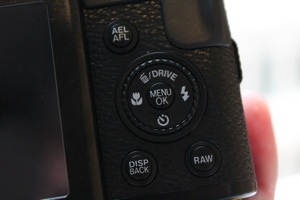

Features


Fujifilm fancies the X10 much too classy for shooting gimmicks, so it mostly keeps things simple. Every feature is geared toward getting the best image quality out of the camera, and they’re mostly just tweaks to the shooting settings — like a dynamic range priority mode, or a high ISO / low noise image that’s basically the same as every other camera’s Night mode, just with more impressive language.
The omnipresent scene modes are here, as well as a few simple filters for both photos and video that are particularly adept at giving video a vintage, film-like quality. Otherwise, there’s a really cool mode for shooting 360-degree panoramic photos all in one shot, and not much else. The feature I wound up using most was just a simple level, which helps keep the horizon in your photos consistent.
The X10 takes fantastic pictures, in almost any situation. Its ⅔-inch CMOS sensor may be closer in size to a point-and-shoot than a DSLR, but the photos it takes are definitely closer to DSLR-quality, even though they’re not quite on that level. Much of that is due to the Fujinon lens, which ranges from f/2.0 to f/2.8 — that’s incredibly fast, especially at the most zoomed-in angle; typically, zooming makes for darker photos, but that’s barely the case with the X10. The X10 can go from 28-112mm, which is 4x zoom, and that it zooms at all is an upgrade over the X100’s fixed lens.
Even in low light, the X10 continues to take impressive pictures. Since the lens is so fast, it doesn’t need low shutter speeds or ridiculously high ISOs to take in a lot of light, so the blurry-or-soft problem you run into with a camera like the Nikon J1 doesn’t really exist. I was able to shoot up to ISO 1600 without much problem, though that was the point when I started to notice significant noise in the image. Photos at ISO 3200 and even occasionally 6400 were still usable, but only at small sizes. Some of the awesome noise performance is thanks to Fujifilm’s dual-core EXR processor — there’s an EXR mode on the camera, and when you’re in it the camera will automatically switch its settings so that in low light it’s only shooting 6-megapixel photos, combining pixels so that there’s less noise in the photo. It’s a smart idea, and it clearly works.
The autofocus is insanely fast, taking virtually no time to lock on to a subject, and typically getting it right, though its face detection performance wasn’t great. There are 49 available points of autofocus, so you can easily choose where you want the camera to lock. Manual focusing is done through the camera itself rather than on the lens, and you actually use the scroll wheel on the back of the camera to focus it; it feels funny at first, but works fine once you get used to it. The one issue, and this is common with rangefinder-style cameras, is close-up focus. The X10 doesn’t do a very good job focusing on close subjects — I spent a lot of time trying to get close-up photos looking right, and was rarely closer than about a foot. There’s an awesome Super Macro mode, which lets you focus as close as 1cm away, but you have to remember to switch into the mode before you try and shoot; it’s an great feature, but one that requires some work and training on your part.
The important things happen really fast on the X10, but it’s got its share of lag as well. As mentioned before, there is virtually zero shutter lag, which is fantastic, and it can shoot up to seven frames per second (ten if you’re shooting at the smaller 6-megapixel setting). Other parts of the camera don’t really keep up, though. The X10 takes two or three seconds to turn on when you rotate the lens, and if the camera’s sleeping it can take even longer to wake up; sometimes it was just faster to turn it off and back on than to hold the shutter for five seconds to get it to wake up again.
You can shoot video at 1080p at 30 frames per second, and it looks really good even in low light. As with still photos, accurate and clear colors are everywhere, and video looks crisp and clean. The camera can autofocus and zoom while recording video, without making any noise that I could hear. Often, cameras that can shoot 1080p30 can also shoot 720p60, a combination I personally love, but this one’s 30 fps at both resolutions. The camera has a stereo microphone, which sounds pretty great — a taxi’s sound moved from my left to my right as the cab did, and the two mics seem to do a decent job of eliminating background noise (though not a perfect one).
There’s a whole lot of good stuff inside the X10, but you won’t get to make use of it for very long — its battery life is really, really bad. I took all of 169 photos and one 40-second video before the battery died, so plan to buy an extra if you’re doing some serious shooting. It did get better after charging a few times, but it’s still not enough for a heavy shooter.



If you’re willing to put in the time to really get acquainted with the X10, the reward is huge
As much as I like the Fujifilm X10, it’s not a camera I’d recommend to most average camera buyers. It’s drop-dead gorgeous and it works really well, but it’s quite complicated to use, and there’s a fairly steep learning curve if you want to make the most out of the camera. With no interchangeable lenses it’s not versatile enough to be a primary camera for serious shooters, and it’s potentially too much for hobbyists to make use of its best features.
If you’re willing to put in the time to really get acquainted with the X10, the reward is huge — it takes excellent photos and video, and will get more than a few envious looks while you shoot with it in public. But at $599.99, I’d wager most people will be more comfortable with the Sony NEX-5N, or the Olympus E-PL3, both of which have larger sensors, multiple lenses, and a much smaller learning curve. Or, you could save $170 and drop down to the Canon PowerShot S100, which doesn’t offer quite the same image quality pictures, but is small and dead simple to use.
:format(webp)/cdn.vox-cdn.com/uploads/chorus_asset/file/12789311/X10-hero-1020px.1419963359.jpg)
:format(webp)/cdn.vox-cdn.com/uploads/chorus_asset/file/12789311/X10-hero-1020px.1419963359.jpg)
Share this story